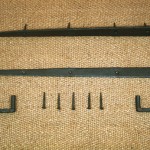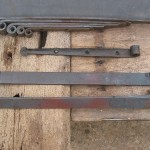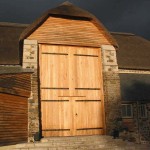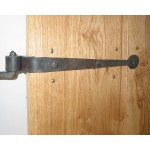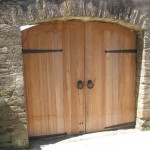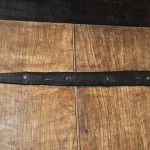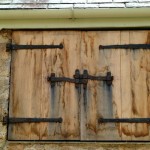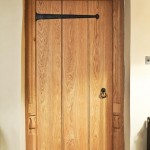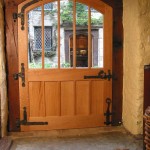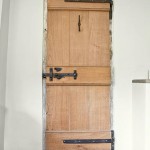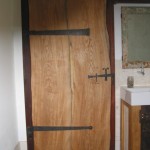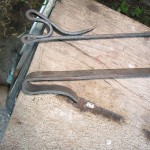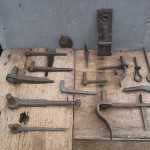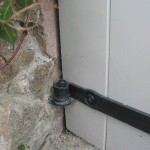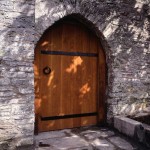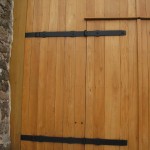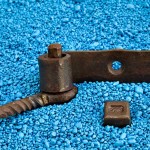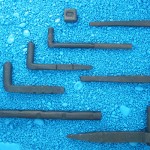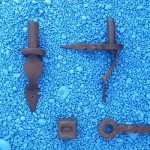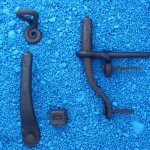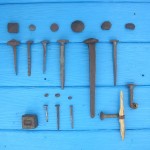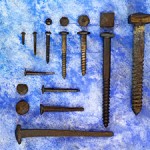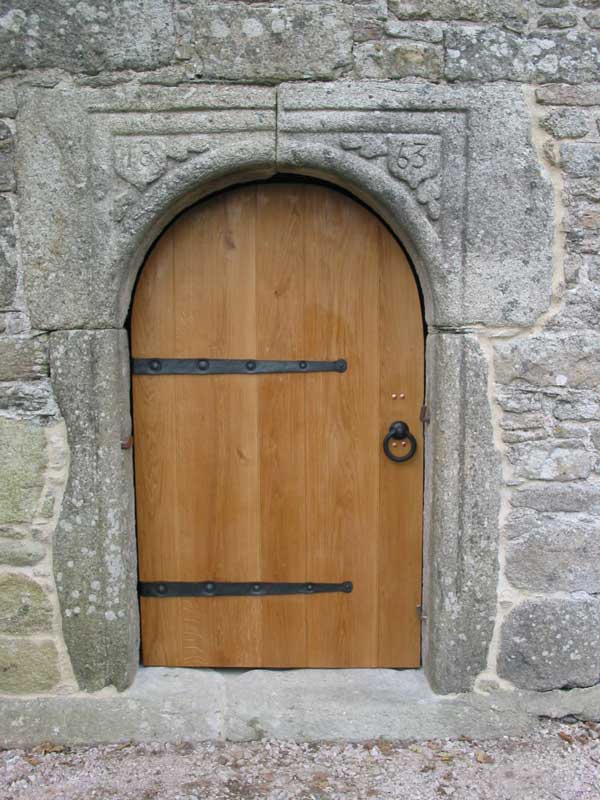
.
In the Hinges section of the shop I offer two sizes of forged strap hinge as off the peg items. Their design and crafting are totally traditional but I feel that the possible variations are too numerous to attempt production of a comprehensive range of forged straps.
Even plain, traditional strap hinges tend to be a bit more bespoke than ‘plate’ hinges, with more variables to be considered; there are the basic traditional forms – the leaf and button end – but then there can be varieties of shape – parallel sided or tapered -, variety of finial and decoration and then, of course, a number more choices when one gets to the business end and the pintles and relation of surfaces of door to frame or wall- not to mention the issues around fixings and fastenings.
I can forge for you straps of pretty much any size and configuration, with all the necessary hardware – pintles, nails etc. – I do need a certain amount of detail (see bottom of page) in order to be able to arrive at good solutions, but then I would say that beautiful doors, old or new, have just got to be worth the bother.
So here are some that I made earlier…..(if you wish to get a better idea of context, most of these jobs are chronicled in the commissions section of the site under door and window furniture)
- straps with nails and pintles
- strap details
- overview
- cranked strap on face
- cranked gate straps
- rough forged strap on adzed door
- shutter straps
- dummy straps
- hot pressed straps
- flat bar straps
- ‘push pull’ straps
- push pull strap detail
- various pintles
- pintle detail
- mediaeval guest house straps
- barn door bifolding straps
- screw in ‘seated’ pintle in strap eye
And then there are a few variations on the pintles;
- single fix pintles
- double fix pintles
- triple fix pintles
Many of these hinges have been nail fastened. I make nails and clench nails for the ironmongery I supply as well as supplying appropriately finished fixings of mass produced origin. The fastening of ironmongery requires close attention to detail in both design and making and is, in my opinion, completely central in the quest for good results.
Illustrated below; Left hand image, top left a decorative square headed stud for a studded castle type door; the next two, going clockwise, are ribbed nails that we make for situations where clenching is not considered desirable; the forged ribbing aims to act in the same way as the machined rings on the shanks of ‘gripfast’ nails but the heads are slightly more interesting. The fourth nail is designed for the fixing of large strap hinges; the nails are driven in at angles opposed to each other so that the ironwork cannot pull off or work loose) and the last blow makes use of the thinned section of shank under the head to allow the nail head to be driven down flush to the surface of the hinge. Then there is a large spike or dump and, on its’ right, a 70mm clench nail with, beneath it some clench nails that we used and then split out of the wood to see what they had done out of sight. The three little nails are cut nails (40 mm and 30mm ) with reworked heads flanking the machine made rosehead in the middle.
The second picture documents a few variations of coach screws with reforged heads as well as a few sizes of nail and some distressed dome head screws – all strategies that we use as required to achieve satisfactory fixing details.
- forged nails
- various reworked screw fixings and some plain nails
I need as much detail as possible to ensure a successful outcome. (Most of which would be provided by a detail drawing of the door and frame and a section of the door and frame at the point of the straps) Points to cover include:
The size, approx weight, material and configuration of the door and the dimensions of the frame
The relation of the door to the frame or wall.
On which face of the door do you want the straps to be?
Are the pintles to be set into masonry or timber?
What are the widths of the door planks (so that the fixing holes are not on the joints) and the thickness of timber at point of fastenings?
Any peculiarities of the situation that might affect how one would go about things. For example low ceilings which could prevent one from lifting the door off its pintles if that were to ever be necessary
Further details of all these jobs and more can be seen in the Commissions Gallery
